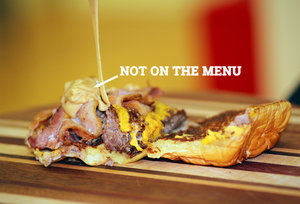Colombia -- yes, it's one of the world leaders in producing coffee
and Sofia Vergara, but what else is there to this lush South American
nation? Turns out it's home to some of the best cuisine out there: a mix
of South American, Spanish, and French influences that're given a
regional kick by each of the country's distinct cultural regions, from
the Andes Mountains to the low marshlands. And while it may share the
rights to the
exalted arepa with neighbor Venezuela, Colombia's got a whole slew of traditional dishes all its own.
So in the interest of unearthing the best of what Colombian cuisine
has to offer, we polled a number of our food-loving Colombian friends to
find out what the country's truly got the munchies for. Let's get
cooking.
Bandeja paisa
What it is: Red beans and pork, white rice, fried eggs,
plantains, chorizo, arepas, hogao/criollo (a tomato and onion based
sauce), chicharron, and ground meat
What's the deal: Coming out of the mountainous Paisa
region in Northwest Colombia, this doozy of a dish incorporates pretty
much all of the most commonly used Colombian foods and ingredients onto
one massive platter. It contains elements of indigenous cooking as well
as Spanish influences, and it was also almost named the national dish of
Colombia, but folks from the other regions wanted a more democratic
selection.
Ajiaco
What it is: A stew made primarily of chicken, corn, hot peppers, and potatoes
What's the deal: Ajiaco is a slightly stronger
contender for the national dish of Colombia since it’s heavily consumed
in more regions of the country, but it still hasn’t been officially
selected by the government. Luckily, you don't need government
permission to eat this spicy Andean specialty, as it holds a permanent
spot in the comfort food pantheon of Colombia. It has a slightly grassy,
earthy flavor due to the addition of guascas, an herb common to the
area around Bogota.
Almojabana
What it is: A pocket-like type of bread made with cuajada cheese
What's the deal: A fixture at most Colombian bakeries,
almojabana is a corn flour-based biscuit with the cottage cheese-like
cuajada mixed into the dough, along with eggs, butter, and sugar. It's a
popular breakfast accompaniment, and its name is derived from the
Arabic word almugábbana, meaning “mix made with cheese”.
Lechona
What it is: Roast pig stuffed with rice, yellow peas, potatoes, onions, and spices
What's the deal: Served on many a special occasion in
the region of Tolima and elsewhere in the country (especially on
Colombian Independence Day), lechona is essentially a suckling pig
roasted with vegetables and spices, and then carved up with rice. The
crispy skin of the pig is highly valued and is served alongside the
platter as a tasty accoutrement to a dish that’s pretty much already
going whole-hog.
Tamale
What it is: Corn masa, meat, and veggies wrapped up snugly in a banana or plantain leaf
What's the deal: We may think of tamales as being a
distinctively Central American food, but the truth is that they’re
present all over the Latin American world. The Colombian iterations are
noticeably larger than their Mexican brethren, as their corn husks have
been substituted with plantain leaves. Pour a cup of hot chocolate next
to it, and you've got yourself a common Colombian breakfast.
Liz Newman
Arepa
What it is: Crispy-on-the-outside corn cake that can be baked, fried, steamed, or boiled -- is also used as a base for sandwiches
What's the deal: Thought
arepas were just Venezuelan?!
THINK AGAIN, PERSON WHO SPENDS A LOT OF TIME CONSIDERING AREPAS! These
delicious, crispy corn cakes are just as Colombian as they are
Venezuelan, and they're eaten frequently for breakfast or as an
afternoon snack. Common fillings include butter, eggs, cheese, chorizo,
or the hogao/criollo sauce we mentioned earlier. The history of the
arepa goes back hundreds of years to the early corn masa biscuits of
Colombia’s indigenous tribes.
Ternera a la llanera
What it is: Beef, veal, pork -- basically anything you want, as long as it’s the whole animal
What's the deal: The Colombian version of barbecue,
ternera a la llanera involves taking the entirety of a young cow,
butchering it very carefully in order to preserve a bunch of tender,
thin cuts of meat, and skewering them over a conical fire pit that
smokes the meat as it’s cooked. This style of cooking is particularly
popular in the marshlands of Colombia, and will probably
become popular everywhere this article is read.
Adam Lapetina is a food/drink staff writer at Thrillist, and can't wait to try some bandeja paisa while watching the Colombian version of Breaking Bad
. Read his musings on Twitter at @adamlapetina.

 11451
11451











No comments:
Post a Comment
Please leave a comment-- or suggestions, particularly of topics and places you'd like to see covered